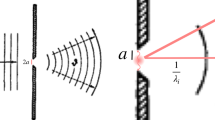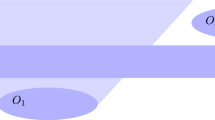Abstract
I show why old and new claims on the role of counterfactual reasoning for the EPR argument and Bell’s theorem are unjustified: once the logical relation between locality and counterfactual reasoning is clarified, the use of the latter does no harm and the nonlocality result can well follow from the EPR premises. To show why, after emphasizing the role of incompleteness arguments that Einstein developed before the EPR paper, I critically review more recent claims that equate the use of counterfactual reasoning with the assumption of a strong form of realism and argue that such claims are untenable.

Similar content being viewed by others
Notes
A side remark. Given a thesis X, it is quite peculiar to say that a certain argument both ‘assumes’ and ‘concludes’ X: the logical status of X within the argument—hence, the argument itself—changes dramatically if X is an assumption or the outcome of a derivation! As we will see later, this is exactly the heart of the matter with counterfactual definiteness in EPR-Bell kind of arguments.
This is one of the episodes in the history of contemporary physics where the received view of Einstein as a reactionary scientist, unable to follow the more promising lines of development of the new physics in the second half of his life, proves so dramatically inadequate. As an instance of this inadequacy, let me recall what Werner Heisenberg said in his introduction to The Born–Einstein Letters, commenting on the Einstein’s attitude toward quantum mechanics: “Most scientists are willing to accept new empirical data and to recognize new results, provided they fit into their philosophical framework. But in the course of scientific progress it can happen that a new range of empirical data can be completely understood only when the enormous effort is made to enlarge this framework and to change the very structure of the thought processes. In the case of quantum mechanics, Einstein was apparently no longer willing to take this step, or perhaps no longer able to do so” (Born 2005, xxxvii).
This theory is downgraded by Arthur Fine to the status of a ‘semantic’ theory of disturbance (Fine 1986, 35).
A further, simplified version of the Einstein 1927 thought experiment is due to Hardy (1995). A slightly different formulation, inspired by the argument that Einstein proposed in 1927, is known as the Einstein boxes experiment and supposed to emphasize even more dramatically the dilemma between locality and completeness. This kind of thought experiment is reformulated by Einstein in the letter to Schrödinger of June 19th, 1935, in which he complains about the published version of the EPR argument: see the discussion of it in Fine (1986, 35–38), and Norsen (2005) for a thorough and more recent analysis.
It should be pointed out that λ can just be ψ.
The standard reference for all arguments relying on the equivalence between factorizability and existence of a joint probability distribution is Fine (1982): see also Mermin (1992), where the author writes: “Bell’s theorem, although it does rely on the properties of a particular state, proves the non-existence of a joint distribution for a set of observables required to have one by an apparently common-sense notion of physical locality” (27, my emphasis). In addition to the argument defended above in the main text, it can be shown that the Fine deterministic hidden variable model implicitly assumes locality anyway (Shimony 1984; Laudisa 1996).
A remark in sociology of science: since the American Journal of Physics is the intended journal of US physics teachers, it is an revealing sign that in two issues of the journal in two different years readers are pedagogically taught that a ghostly assumption like counterfactual definiteness does play an essential role in the EPR argument and in the ensuing Bell theorem!
For older, notable statements in the same direction see e.g. Unruh (1999, 2001). It should be noted that, historically, there is an interesting antecedent to the discussion in the text, namely the debate surrounding the counterfactual formulation of the Bell theorem proposed especially by Eberhard (1977, 1978), Stapp (1985a, b) and Kraus (1989). In 1990, Butterfield et al. by applying the very conceptual resources of the Lewisian theory of counterfactual conditionals to the Eberhard–Stapp–Kraus formulation, could show that such formulation in fact embodied an implicit assumption of determinism: in that context such assumption is de facto equivalent to counterfactual definiteness, which in turn leads us back to the issue that I discuss in the text.
Maudlin goes as far as claiming that the EPR criterion—what I call here Reality—is an analytic criterion, namely a criterion that simply follows from the very meanings of the words that compose it (Maudlin 2014, 424010-6).
In the so-called consistent-histories approach, that Gell-Mann, Hartle, Griffiths, Omnes (and others) have developed in detail, it is also claimed that locality can be preserved for quantum mechanics: see for instance Griffiths (2011). Arguments that show this claim to be far from convincing can be found in Goldstein et al. (2011) and Maudlin (2011).
References
Bacciagaluppi, G., & Valentini, A. (Eds.). (2009). Quantum theory at the crossroad. Reconsidering the 1927 Solvay conference. Cambridge: Cambridge University Press.
Bell, J. S. (1975). The theory of local beables, CERN publication TH-2053-CERN (reprinted in Bell 2004, pp. 52–62).
Bell, J. S. (2004). Speakable and unspeakable in quantum mechanics (2nd ed.). Cambridge: Cambridge University Press.
Bertlmann, R. A., & Zeilinger, A. (Eds.). (2002). Quantum (un)speakables. From Bell to quantum information. Berlin: Springer.
Blaylock, G. (2010). The EPR paradox, Bell’s inequality, and the question of locality. American Journal of Physics, 78, 111–120.
Born, M. (2005). The Born–Einstein letters 1916–1955. New York: McMillan.
Boughn, S. (2017). Making sense of Bell’s theorem and quantum nonlocality. Foundations of Physics, 47, 640–657.
Butterfield, J., Clifton, R., & Redhead, M. L. G. (1990). Nonlocal influences and possible worlds—A Stapp in the wrong direction. British Journal for Philosophy of Science, 41, 5–58.
Eberhard, P. H. (1977). Bell’s theorem without hidden variables. Il Nuovo Cimento, 38B, 75–80.
Eberhard, P. H. (1978). Bell’s theorem and different concepts of locality. Il Nuovo Cimento, 46B, 392–419.
Einstein, A. (1949). Autobiographical notes. In P. A. Schilpp (Ed.), Albert Einstein philosopher-scientist. New York: Harper Torchbooks.
Fine, A. (1982). Hidden variables, joint probability and the Bell inequalities. Physical Review Letters, 48, 291–295.
Fine, A. (1986). The Shaky Game. Einstein realism and the quantum theory. Chicago: University of Chicago Press.
Gell-Mann, M., & Hartle, J. (1989). Quantum mechanics in light of quantum cosmology. In Proceedings of the third international symposium on the foundations of quantum mechanics, Tokyo (pp. 321–343).
Goldstein, S., Norsen, T., Tausk, D., & Zanghì, N. (2011). Bell’s theorem. Scholarpedia, 6(10), 8378.
Griffiths, R. B. (2011). EPR, Bell and quantum locality. American Journal of Physics, 79, 954–965.
Hardy, L. (1995). The EPR argument and nonlocality without inequalities for a single photon. Annals of the New York Academy of Sciences, 755, 600–615.
Home, D., & Whitaker, A. (2007). Einstein’s struggles with quantum theory. Berlin: Springer.
Howard, D. (1993). Was Einstein really a realist? Perspectives on Science, 1, 204–251.
Kraus, K. (1989). Quantum theory does not require action at a distance. Foundations of Physics Letters, 2, 1–6.
Laudisa, F. (1996). Nonlocality: A defense of widespread beliefs. Studies in History and Philosophy of Modern Physics, 27, 297–313.
Maccone, L. (2013). Simplest proof of Bell’s inequality. American Journal of Physics, 81, 854–859.
Maudlin, T. (2011). How Bell reasoned: A reply to Griffiths. American Journal of Physics, 79, 966–970.
Maudlin, T. (2014). What Bell did. Journal of Physics A: Mathematical and Theoretical, 47, 424010.
Mermin, N. D. (1992). Not quite no simply no hidden variables. American Journal of Physics, 60, 25–27.
Norsen, T. (2005). Einstein’s boxes. American Journal of Physics, 73, 164–176.
Peres, A. (1978). Unperformed measurements have no result. American Journal of Physics, 46, 745–747.
Shimony, A. (1984). Contextual hidden variable theories and Bell’s inequalities. British Journal for the Philosophy of Science, 35, 25–45 (reprinted in Search for a Naturalistic World View. Vol. II Natural Science and Metaphysics, Cambridge University Press, Cambridge, 1993, pp. 104–129, reference to the reprinted edition).
Stapp, H. P. (1985a). Bell’s theorem and the foundations of physics. American Journal of Physics, 53, 306–317.
Stapp, H. P. (1985b). EPR: What has it taught us? In P. Lahti & P. Mittelstaedt (Eds.), Symposium on the foundations of modern physics (pp. 637–652). Singapore: World Scientific.
Unruh, W. G. (1999). Nonlocality, counterfactuals, and quantum mechanics. Physical Review A, 59, 126–130.
Unruh, W. G. (2001). Is quantum mechanics non-local? In T. Placek & J. Butterfield (Eds.), Non-locality and modality (pp. 125–136). Dordrecht: Kluwer.
Whitaker, A. (2016). Richard Feynman and Bell’s theorem. American Journal of Physics, 84, 493–494.
Wolf, S. (2015). Nonlocality without counterfactual signalling. Physical Review A, 92, 052102.
Zukovski, M., & Brukner, C. (2014). Quantum nonlocality—It ain’t necessarily so…. Journal of Physics A: Mathematical and Theoretical, 47, 424009.
Author information
Authors and Affiliations
Corresponding author
Rights and permissions
About this article
Cite this article
Laudisa, F. Counterfactual Reasoning, Realism and Quantum Mechanics: Much Ado About Nothing?. Erkenn 84, 1103–1118 (2019). https://doi.org/10.1007/s10670-018-9997-4
Received:
Accepted:
Published:
Issue Date:
DOI: https://doi.org/10.1007/s10670-018-9997-4




